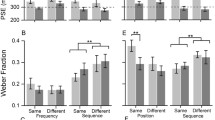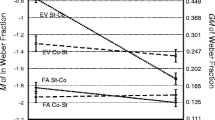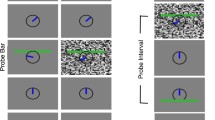Abstract
For time intervals in the 150–1500 ms range, the difference-discrimination thresholds are about 5%. The value of this Weber fraction varies somewhat depending whether the stimulus modality is vision, hearing or touch. Thresholds are higher when a time interval signaled in one modality has to be compared with one in another, and also when two different modalities are used to delineate a single time interval, as well as when onset and offset are in the same modality but signaled to opposite cortical hemispheres. There is a prominent practice effect. This effect was used to show that there is complete transfer of training between the two visual hemispheres. These findings imply that the time-discrimination mechanism is not located at an early stage of visual processing. If there is a single central time-discrimination apparatus, the observed intermodal differences must relate to the relative ease of access to it via different modalities. The mechanism involved needs elucidating. Counting of spikes or internal time modules would seem to be too simplistic a concept; there is still a need for a process in which the duration of a just concluded presentation and an internally stored interval duration can be compared.
Similar content being viewed by others
Author information
Authors and Affiliations
Additional information
Received: 22 September 1998 / Accepted: 19 May 1999
Rights and permissions
About this article
Cite this article
Westheimer, G. Discrimination of short time intervals by the human observer. Exp Brain Res 129, 121–126 (1999). https://doi.org/10.1007/s002210050942
Issue Date:
DOI: https://doi.org/10.1007/s002210050942




